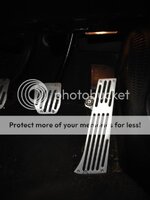Heel & Toe is pretty easy if you don't use the "Conventional" method, by which I mean using the ball of your foot to do the braking and the bottom of your heel to do the blipping, that in the Zed is very difficult.
However..
If you use the technique that I adopted by using the ball of your foot (Under your "Big" toe) position that approx 50% on the brake pedal bias to the right (Closest to throttle pedal).
Then using your outer part of your foot (The leading edge from your little toe) to blip the throttle, you will quickly learn how to modulate the brake and throttle together.
For those who have never tried "Heel and Toe" I would try "Rev matching" first in the Zed just to get your engine speed changes up to scratch so you don't have to concentrate on looking at the speedo etc when you do it.
It should all be done by "feel"
Good luck
However..
If you use the technique that I adopted by using the ball of your foot (Under your "Big" toe) position that approx 50% on the brake pedal bias to the right (Closest to throttle pedal).
Then using your outer part of your foot (The leading edge from your little toe) to blip the throttle, you will quickly learn how to modulate the brake and throttle together.
For those who have never tried "Heel and Toe" I would try "Rev matching" first in the Zed just to get your engine speed changes up to scratch so you don't have to concentrate on looking at the speedo etc when you do it.
It should all be done by "feel"
Good luck

